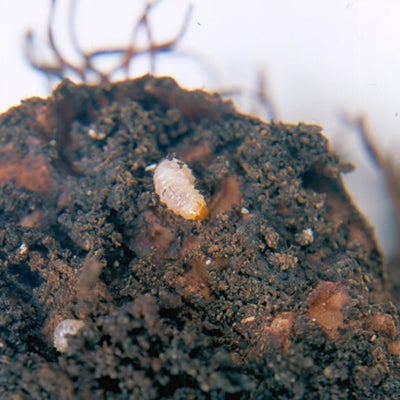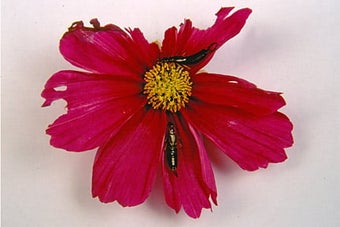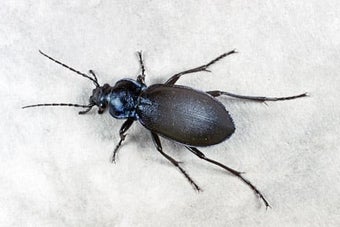
Quick facts
Common name - Vine weevil
Scientific name - Otiorhynchus sulcatus
Plants affected - Ornamental plants and some fruits, especially those grown in containers
Main symptoms - Adult weevils notch leaf margins; grubs eat roots
Most active - Adult weevils spring to late summer; grubs summer to spring
What is vine weevil?
Vine weevils are beetles with broad snouts, they can feed on a wide range of plants, both indoors and outdoors, but can be especially damaging to plants grown in containers. It is a very widespread and common insect. The adult weevils eat leaves during spring and summer, but it is the grubs that can cause the most damage over autumn and winter when they feed on plant roots. This damage can result in wilting and plant death. Adult vine weevils are mainly active after dark, during the day the beetles hide in leaf litter beneath their host plants.
Plants growing in pots and containers, outdoors or under cover, are most likely to be severely damaged by vine weevil grubs. Plants growing in the open ground are less likely to be damaged, although heavy infestations of grubs can occur on strawberries, Primula, polyanthus, Sedum, Heuchera and young yew plants.
The adult beetles feed on the foliage of many herbaceous plants and shrubs, especially Rhododendron, evergreen Euonymus, Hydrangea, Epimedium, Bergenia, Primula and strawberry. Adults rarely cause enough damage to affect the vigour of plants.
There are 25 other species of weevil closely related to vine weevil, such as the privet weevil Otiorhynchus crataegi and the recently arrived O. armadillo. The adults of these other species cause similar damage but in gardens are usually less problematic as larvae. Unlike the vine weevil several of these other species have males and females and reproduce sexually.

How do you know if you have vine weevil?
You may see the following:
- Vine weevil grub symptoms: Plants can wilt and die during autumn to spring as a result of the larvae devouring the roots, those being grown in containers are more susceptible
- Vine weevil grubs amongst the roots of your plants: The plump c-shaped white legless larvae have light brown heads and are up to 10 mm (about 3/8 in) long. They are likely to be found among the roots
- Adult feeding symptoms: Irregular-shaped notches of leaf margins during the summer. If damage is to privet it may have been caused by the Privet weevil, Otiorhynchus crataegi - the larvae this species does not normally cause noticeable damage to host plants in gardens
- The adult weevils themselves: Weevil type beetles, approximately 9 mm (about 5/16 in) long, with dull black with dirty yellow mark on the wing cases
What should you do about vine weevil?
Vine weevil is a very widespread insect in Britain. Gardeners with vine weevil should keep up their guard because after the apparent disappearance of the weevil numbers can build up again, which can be problematic when susceptible plants are being grown.
- Tolerate leaf damage caused by the adult beetles
- Remove beetles by hand where practical. On mild spring or summer evenings inspect plants and walls by torchlight and pick off the adult weevils. Shake shrubs over an upturned umbrella, newspaper or similar to dislodge and collect more. In greenhouses, look under pots or on the underside of staging benches where the beetles hide during the day
- In greenhouses trap adults with sticky barriers placed around pots or on staging
- Encourage wildlife in the garden. Vine weevils and their grubs are eaten by a variety of predators such as birds, frogs, toads, shrews, hedgehogs and predatory ground and rove beetles
- Check susceptible plants frequently so action can be taken before a damaging population has developed. Look for notched leaves particularly on thick leaved evergreen plants such as rhododendron as a sign adults are present
- Repot plants, removing as many larvae as possible from around roots and
Biological control
- Biological control for the larvae is available as microscopic insect pathogenic nematodes. Several species and combinations are available (Steinernema kraussei, Heterorhabditis megidis, H. bacteriophora and S. feltiae).They are available from suppliers of biological controls and as sachet formulations available from some retail outlets. They are suitable for use in containers and in the open ground. Nematodes have the potential to infect other animals. They should therefore be used with care and only when there is a specific problem to treat
- For best results apply in August or early September when the soil temperature or potting media is warm enough for the nematodes to be effective (Steinernema species 5-20ºC/41-68ºF Heterorhabditus species 12-20ºC/ 54-68ºF) and before the vine weevil grubs have grown large enough to cause serious damage
- The nematodes can give poor results in dry or heavy soils. They work best in lighter soils and open potting composts, such as peat or coir. Nematodes can be used safely on all edible and ornamental plants
- A trap containing nematodes (Steinernema carpocapsae), is available for controlling adult vine weevil. The traps should be placed on the ground below plants damaged by the weevils during the summer. The adults enter the trap during the day and are infected by the nematodes
Biology
Weevils are a group of several families of beetles in the superfamily Curculionoidea, there are more than 500 species in the UK. All feed on plant material, mostly live plants but a few feed on dry seeds (grain weevils) or rotting wood. Most do not cause noticeable damage to garden plants and several species are uncommon. Vine weevil is classified in a subfamily of weevil known as the broad nosed weevils (Entiminae), so called because of the broad snout (rostrum) these weevils have. There are over 100 species in this subfamily in Britain. More information on broad nosed weevils from UK Beetles.
Adult vine weevils cause notch like leaf damage, however this rarely affects plant growth. The adults are 9mm (about 5/16in) long, dull black beetles with a pear-shaped body when viewed from above. Adult weevils may be seen on the foliage at night; during the day they hide in dark places. They are slow-moving insects that cannot fly but they are excellent crawlers and climbers. There are several other related species found in Britain which can cause similar damage to foliage as adults. Some that have recently become established include Otiorhynchus armadillo, O. crataegi and O. salicicola.
More serious is the damage can be caused by the soil-dwelling larvae, which are plump, white, legless grubs up to 10mm (about 3/8in) long with pale brown heads. These eat the roots of a wide range of plants and can bore into tubers of cyclamen and begonia, and into stem bases of cacti and . They can kill woody plants by gnawing away the outer tissues of the larger roots and stem bases. Most plant losses occur during September to March, when the grubs are becoming fully grown.
All Otiorhynchus sulcatus adults are female and each can lay several hundred eggs during spring and summer, reproducing asexually. This is not true for all Otiorhynchus species, for example O. armadillo is often found mating. The eggs are brown and less than 1mm (about 1/16in) in diameter, making them very difficult to see in soil. Larger yellowish-brown spherical objects seen in potting composts are likely to be controlled-release fertiliser pellets added by the nursery that raised the plants.














